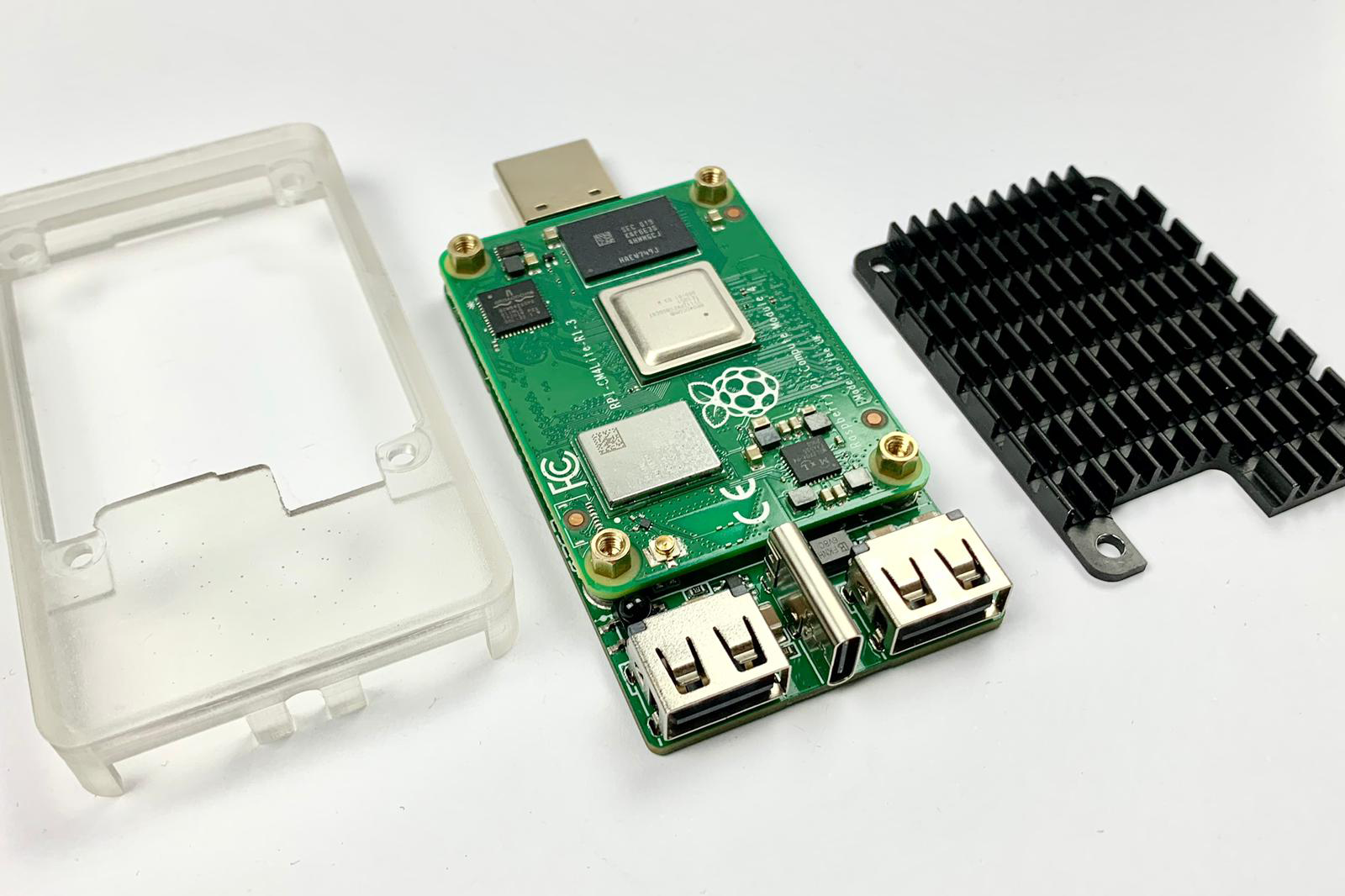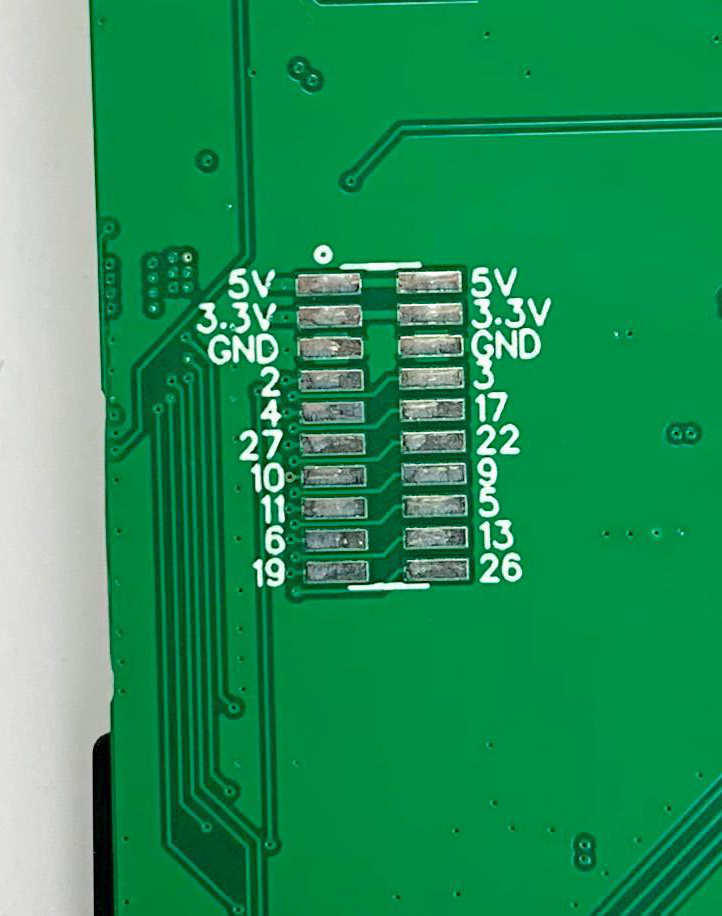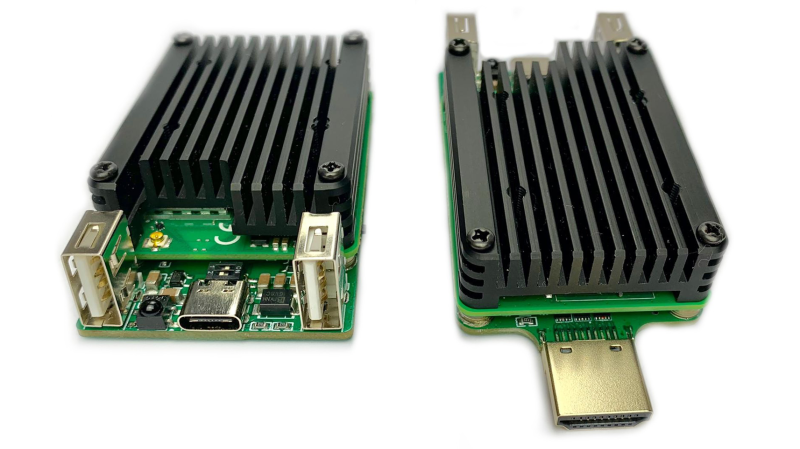We agree with [magic-blue-smoke] that one of the only things more fun than a standard Raspberry Pi 4 is the Compute Module form factor. If they are not destined to be embedded in a system, these need a breakout board to be useful. Each can be customized with a myriad board shapes and ports, and that’s where the real fun starts. We’ve already seen projects that include custom carrier boards in everything from a 3D Printer to a NAS and one that shows we can build a single-sided board at home complete with high-speed ports.
[magic blue smoke] used this ability to customize the breakout board as an opportunity to create a hackable media player “stick” with the Raspberry Pi built-in. We love that this Raspberry Pi CM4 TV Stick eliminates all the adapters and cables usually required to connect a Pi’s fiddly micro HDMI ports to a display and has heat sinks and an IR receiver to boot. Like a consumer media player HDMI stick, all you need to add is power.

This seems like a super-clean way to get a media player or retro gaming on a TV or start developing your own custom smart TV without all the security concerns that come with an off-the-shelf device. But wait, there’s more! [magic-blue-smoke] has already broken out 14 GPIO pins on the board for hardware hacks and plans to add connections for “Ambilight” LEDs in a future version. We’d like to see some IR LEDs to control older AV gear added too.

















That heat sink is pretty slick, where can I get one of them?
I thought so too. But an L shaped plastic with double adhesive could be used as a shelf and do the trick
Looking at the slightly rough finish around the wifi cutout I’m fairly sure that isn’t a commercial product, its a AL heat sink sheet machined to suit. I agree though I kind of want one, its far less overkill than the heat sink on my desk CM4 (which is around 1/2 of a old Aluminium heat sink from some old full size processor)…
You can buy them. Search for “CM4 heatsink”.
I did, once upon a time when I first ordered CM4’s.. I guess they didn’t exist yet as I didn’t find anything this neat just lots of those loose stick on type ones.
Nice to be wrong once in a while, and a good reminder to actually look and see if something has changed, or you forgot something etc.
Search for “CM4 heatsink” and you’ll find both of them. The small one is sold by Waveshare and big one is sold by Geekworm.
That protruding HDMI connector will be the most common point of failure for this board.
It’s also pretty much the whole point of it … So what do you suggest
Use a female hdmi socket like any other “larger than a stick of gum” designed product.
Then the board can be mounted/glued/3m taped to the tv or out of sight and the cable will resolve the issue with strain.
The “Volkswagen model” of putting high mechanical and electrical loads on the same connector on a circuit board. If you ever had one fail on you (in the rain, at night, in eight lanes of bay area traffic) you’ll know what I’m talking about. Back in the day, owners would just carry a spare circuit board to swap out.
That said, I’d buy the board and use a flexible cord to solve the problem – a neat (and overdue) idea.
My old 1985 diesel Golf used the alternator as the front engine mount. Oof.
Shouldn’t be too much of a problem – the thing doesn’t weigh anything much and its not being thrown around all the time while plugged in to amplify that weight…
Wouldn’t use it as is in some environments for that reason though, but as a ‘TVStick’ in a normal TV setting it isn’t likely to be a problem, and if you are setting up where it might prove too weedy just use a cable…
raspberry pi is barely able to play media at all in the best of conditions
Wrong software choices maybe? The difficult parts of video decoding can be offloaded to the “video” part of the SoC. 1080p video can be played back with no significant load on the ARM cores, for example with omxplayer.
omxplayer barely supports any formats at all and has numerous other shortcomings. saying “it’s only a software problem” is not much of a deflection when the software is systematically handicapped by the extremely closed nature of the chip and all of its support libraries.
Without suggestions for improvement, this counts as “complaining about the weather”.
my specific suggestion for improvement is to please stop advertising raspberry pi’s platform based on closed source abandonware as ideal for media players
It’s a great media player for the price. Of course a PC with a good GPU is going to be better but good luck finding one of those for $35. You might be able to find some other dev board that’s even cheaper and works just as well, but getting the software part to work the way you want probably won’t be as easy.
Sounds like you’re not offloading to the hardware accelerator. It’s entirely capable.
given the many digital signage solutions that are just a pi + software, you may need to revise that
Think of this as a learning opportunity instead of ego damage.
I mean I was using XBMC on a model 1B back when they first came out with no issues, what’s changed since?
ROFL, nothing negative has happened. It’s not capable today than it was back then.
It just seems the OP has a personal issue, or maybe just feels like trolling today. 🤣
Ugh, it’s MORE capable today… Failure to proof read from my phone. 🤦♂️
everything that worked on model 1b was broken on the next model due to the enormous stack of closed source drivers. everything you do, you run into a problem that someone ran into five years ago but the fix from five years ago doesn’t work today. that’s raspberry pi, and it’s not just media playback but every part of their crap closed ecosystem.
Saw your other comments Greg. Having a hard day?
Lol, their hardware is about as open as its possible to get in remotely comparable format and performance…
I’d go as far as to say its by miles the best because of the great performance of the devices, with a superb community and the responses you will find from the in the know RPI engineers on the forum when a good question is asked…
Also I have every single model of Pi, not once has anything be broken by the later models, a few teething troubles in the default software setup if you are fortunate enough to get one of the really early ones of a new model, but give them and the community time to find and fix and its better than the previous one in every way, except power consumption perhaps…
A solution from 5 years ago frequently won’t work in anything computng based, a copy paste of some ‘fixit script’ option that old is far from certain to work – 5 years is a very very long time in the software world… It might work, or it might not, but you should never be just be trying that stuff – read the man pages, understand what the forum post is pointing you to as the solution, if you don’t understand how it is supposed to work can you be sure random poster “A” is actually geniune, or that some other copy paste script you ran didn’t change your setup in ways that need alterations to this script…
yes, i don’t mind that some 5 year old hack doesn’t work, but unfortunately you never get better than a hack. you never get a real fix, only some blind stab at undocumented garbage. you can never get to the bottom of it, because it’s closed.
“as open as its possible to get in remotely comparable format and performance”. it’s easier to just say “closed.” it’s fewer words. more accurate and more precise.
Greg very little of the Pi is closed…
And there is nothing out there at all that I would call game ready that isn’t vastly more closed, just because the Pi has a little lockbox with some Broadcom secrets in doesn’t negate the fact most of it is there if you want to read about it.
Almost certainly the computer/phone you are bemoaning the state of the Pi on has a great number of closed source binary blobs, probably BIOS too, its pretty much impossible to not have some closed bits in a functional computer.
Same here, only upgraded to I think its the Pi2, maybe 3 back there because I could really, the extra grunt means the behind the TV RPi turns the TV into a pretty fully fledged PC when needed though.
A pi 4 has the raw computing horsepower to decode multiple 1080p files on the CPU alone, heck its able to run multiple virtual machines with cpu simulated graphics and with all that overhead and still play 1080p videos inside them fine (I know I’ve done it on my 8gb model while exploring the limits, which are remarkably hard to find for such a small cheap and versatile platform).. And that doesn’t even consider what the VidCore GPU is capable of – which is a great deal, perhaps you have to put in a tiny bit of work configuring something, but mostly it just works…
omxplayer plays a great many formats, and personally I like it for its lightweight nature, lets even the weaker model pi’s play most media perfectly. But its far from the only choice, the nearly ubiquitous VLC player works on the Pi, its even in the default repository…
As far as I can see a Pi 4 compute module is about the only choice that could be put in this form factor at all anyway! About the only way such computing power and form factor is accessible to your normal maker… And it is perfectly capable of playing media.
“I know I’ve done it on my 8gb model while exploring the limits” you’re telling me a lot there. you’ve set up a lot of pointless garbage on the pi and been impressed that it works at all. have you ever tried to *use* it? my guess is no.
that’s all anyone ever does with pi, because once you start to use it, you recognize nothing actually works. it looks promising on the first hash but then you find out it doesn’t work and the problems that seem minor “oh i’ll just tweak it until it’s good,” you can’t get to the bottom of.
you see this in the dozens of pi-based portable computers on here. pi doesn’t have power management, it is an abhorrent portable computer. people love it because it pops up a shell prompt. you play with it to see if it’s a real shell prompt — it’s a real shell prompt! — then they hit publish. it goes in the closet never to be used again. if you use it, you notice right away these limitations are *severe*. but they never use it. the pi is for projects that don’t get used. i was disappointed to learn this, because no one ever tells this part.
I use it daily, that Pi is my daily driver computer used for 90% of my daily computing tasks… Most all of my comments on this website come from it (though not this one), it does basically all my media playback needs, playing with Virtual machines, network setups etc, even gets used for CAD from time to time – its more than capable enough for most smaller CAD projects, so no point in firing up the slow booting power hog of a workstation…
And I do run 1 VM on it at all times – the social media type crap bubble, that lets me communicate on those platforms I hate and distrust, but which unfortunately is required to keep up with certain friends…
The Pi absolutely can do power management, including a sleep state, is it as effective as everything else perhaps not, but then its so power sipping compared to most things in its performance range you can call computers… I’ve got mine set to throttle down further than stock to 250mhz at idle (lower than that and it rarely got there and didn’t seem stable). And the CM4 on my desk as the electronics project testbed is frequently in sleep state to be woken in bugger all time from the GPIO…
There are limitations on a Pi, even the really quite potent Pi 4 models, but only compared to real desktop hardware costing vastly more, consuming vastly more power, and physically significantly larger. If there is even one remotely comparable board as capable and that actually works (as those weird SBC’s with great specs and awful support that make you take a week just to boot it might be fun but don’t count) I have yet to hear of it… (There are some honourable mentions, some even x86 based that are not Pi products, but even the best of those tend to have much worse documentation and support, its just a much rougher experience)
I’ve spent most of my life trying to find the best TV interface. XBMC was the first open source project I ever contributed to. I’ve built a couple HTPCs. Tried building out a half dozen RPi based boxes. Roku, Chromecast, FireTV, all come and gone. What do I use now? nVidia Shield TV Pro. For me, it is by far the best solution I’ve ever tried. Legit streaming is a breeze. ‘Other’ stuff is available if you want to put on your pirate hat. Good amount of casual games available in the Android ecosystem. Game stream from my PC works good enough. Interface is snappy. HDMI/IR control of any TV I’ve tried is flawless. Best $200 I’ve ever spent on entertainment equipment.
Greg A, ever run libre-elec on it? AFAIK other then the bootloader, everything is open source. While the architecture on the GPU might be crap, that’s a different discussion. Kodi plays pretty much everything thrown at it …
I get the same cringey feeling like when seeing a 3.5mm male to 1/4″ female adapter or a male microusb to female usb-A adapter. Brrr.
And the power connector opposite that making the thing even longer a lever.
No thanks…
Everything sounded good until the line. “all you need to do is add power..” Can’t this be powered off a TV’s USB port ? Or does it require a power brick?
+1 for the title…. Jeff Dunham’s Senior Jalapeno has been replaced by a Pi…… on a steeeek.
I wonder how “Raspberry Pi[e] on a Stick” would sell at the Minnesota State Fair?
(A lot of “____ on a Stick” are sold there each year.)